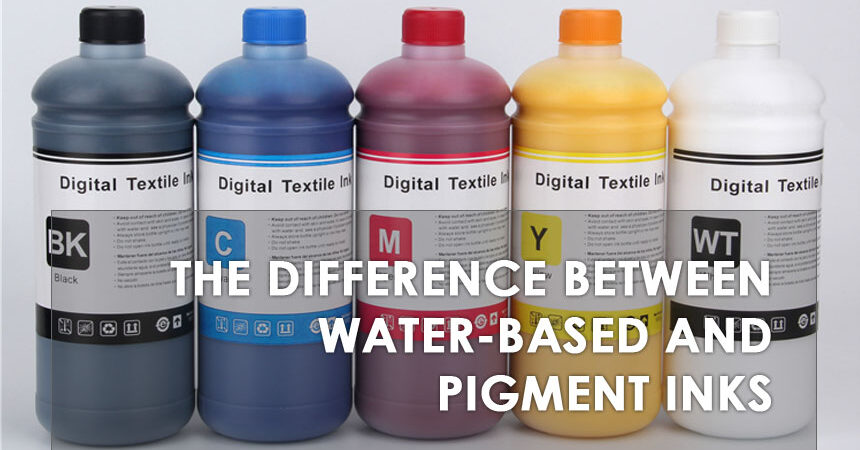The difference between water-based and pigment inks
So, there are two types of ink for printers today. Water-soluble and pigmented. What is the difference between these two types?
Water-soluble inks contain a substance that is soluble in water. Pigmented inks contain a substance that is not water-soluble as a dye.
To illustrate, it makes sense to give an example from everyday life. When a spoonful of sugar falls into water, the sugar dissolves and the water remains clear. The same principle is used to make water-soluble ink. When you pour a spoonful of flour into water, it will not dissolve in water. The fine particles of flour remain in the water in the form of suspended particles. And the water is not at all transparent. This principle is the basis for making pigmented inks.
Each type of ink has its pros and cons.
What is Pigmented Ink?
Pigmented inks have a dyeing substance in them. It is an organic or most often inorganic compound that is not water soluble. It is usually a special type of carbon black.
Pigment are colored solids. And they have the characteristics of a solid. In this case we are talking about volume, diameter and other things. Inks use pigments that are highly pulverized. Suffice it to say that the size of the particles is less than 0.1 microns. To have an idea of the size of such particles, we can say that the thickness of a human hair is about 50 microns.
The particles are so fine that they easily pass through the nozzle plate nozzles of the printhead, which have a diameter of 15-50 microns.
The pigment particles are hydrophobic, that is, they are not wetted by water. And no matter how small they are, if they are thrown into the liquid, they will stick together and precipitate. To prevent this, a dispersant is added to the ink. This is the name of the special component that helps the pigment not to precipitate. In fact, it keeps it suspended in the liquid.
Polymeric materials have become increasingly common as dispersants. That is, nonionic production technology has become very widespread in recent years. A long polymer molecule on the surface of the pigment particle is adsorbed by the non-polar end. And the other end is in water. As a result, the small pigment particles are protected against sticking together – this is what is known as spatial protection.
In addition, the pigment particles are well fixed on the paper. It is very important that after they dry, they do not fall off. However, when ink is produced using non-ionic production technology, the pigment retains its properties of solubility in water. The ink can still dissolve in water, so if the ink gets wet, it can be blurred.
Advantages and disadvantages of pigmented inks
There are additional steps in making pigment ink. The pigment is not only ground in special bead mills. It also goes through dispersion and stabilization in a solution. This makes the process time-consuming. And thereby the cost of production becomes higher.
Let us note that solid particles are abrasive, as well as any solid body. This can explain the fact that the cartridges fail earlier. That is, they wear out a lot.
If the paper is coated, then print on it can not get bright and saturated, as it is, if you use ink, which is based on dyes. That’s because the pigments have duller colors than the dyes.
If you print with dye-based inks, the fibers of the paper are dyed. The pigment solids, on the other hand, remain on the surface of the fibers. They can also “fall through” between the fibers. As a result, the coloring is not continuous.
If something needs to be printed on transparent films, then pigmented inks are not used for this purpose. They are not suitable for that. They take a very long time to dry. In addition, they do not adhere evenly to the film because they have poor adhesion.
However, it should be noted and the undeniable advantages of pigmented inks:
- Printing is sharper. Even when the paper is very bad, the characters don’t blur.
- Images are both water- and light-resistant. That’s why pigmented inks are essentially indispensable if you need to print an image that will then be installed outdoors. They are also called Outdoor, which means for outdoor use.
- It can be used to print on both sides because it does not absorb into the paper.
You need pigment ink if:
Advantages and disadvantages of water-soluble inks
What to choose: water-soluble or pigment ink?
If you have planned the purchase of a color inkjet printer, then we assure you that you are bound to face the problem of choice. That’s because there are currently on the market a sea of printers from many different companies, which have a different number of colors. They also have different types of ink.
Your job is to establish which of the printer models you like already have compatible inks, refillable cartridges and CISS. Why is this so important? The fact that you can buy some novelty, and then suddenly it turns out that it compatible consumables do not produce. And then you will be forced to buy only original cartridges, which cost the user a pretty penny.
Let’s decide right away with the type of ink. Naturally, the buyer in the store asks the salesman what kind of ink is suitable for his printer?
As practice has shown, any four-color printer can be fitted with a CISS or PPC (refillable cartridge kit). Both on pigmented, that is, native inks, and on inks that are based on soluble dyes. They may be called “water-soluble”, “water-soluble”, etc.
IMPORTANT: You can’t say that about photo printers. After all, they originally use inks that are based on soluble dyes.
So, today there are two types of ink for home printers. Water-soluble and pigmented. What is the difference between these two types? Water soluble inks contain a substance that is water soluble as a dye. Pigmented inks contain a substance that is not water-soluble as a dye.
To illustrate, it makes sense to give an example from everyday life. When a spoonful of sugar falls into water, the sugar dissolves and the water remains clear. The same principle is used to make water-soluble ink. When you pour a spoonful of flour into water, it will not dissolve in water. The fine particles of flour remain in the water in the form of suspended particles. And the water is not at all transparent. This principle is the basis for making pigmented inks.
Each type of ink has its pros and cons
Pigmented ink. What is it?
Which should I choose: water-based or pigmented ink? Photo 1
Pigmented inks have a dyeing substance in them. It is an organic or most often inorganic compound that is not water soluble. It is usually a special type of carbon black.
Pigment are colored solids. And they have the characteristics of a solid. In this case we are talking about volume, diameter and other things. Inks use pigments that are highly pulverized. Suffice it to say that the size of the particles is less than 0.1 microns. To have an idea of the size of such particles, we can say that the thickness of a human hair is about 50 microns.
The particles are so fine that they easily pass through the nozzle plate nozzles of the printhead, which have a diameter of 15-50 microns.
The pigment particles are hydrophobic, that is, they are not wetted by water. And no matter how small they are, if they are thrown into the liquid, they will stick together and precipitate. To prevent this, a dispersant is added to the ink. This is the name of the special component that helps the pigment not to precipitate. After all, it keeps it suspended in the liquid.
IMPORTANT: This physical difference from dye-based inks causes pigmented inks to look different in a clear container. They do not appear transparent, but cloudy.
Polymeric materials have become increasingly common as dispersants. That is, nonionic production technology has become very widespread in recent years. A long polymer molecule on the surface of the pigment particle is adsorbed by the non-polar end. And the other end is in water. As a result, the small pigment particles are protected against sticking together – this is what is known as spatial protection.
In addition, the pigment particles are well fixed on the paper. It is very important that after they dry, they do not fall off. However, when ink is produced using non-ionic production technology, the pigment retains its properties of solubility in water. Therefore, if the ink is exposed to moisture, it can be blurred.
IMPORTANT: The pigment, when ionic technology is used, is stabilized by the polymer containing the ion. This occurs through the mechanism of an electrical double layer with a neutralizing component. And therefore, the image that is obtained is resistant to water.
Advantages and disadvantages of pigmented inks
Which should I choose: water-soluble or pigmented ink?
There are additional stages in the manufacture of pigment ink. The pigment is not only ground in special bead mills. It also undergoes dispersion and stabilization in a solution. This makes the process time-consuming. And thereby the cost of production becomes higher.
Let us note that solid particles are abrasive, as well as any solid body. This can explain the fact that the cartridges fail earlier. That is, they wear out a lot.
If the paper is coated, then print on it can not get bright and saturated, as it is, if you use ink, which is based on dyes. That’s because the pigments have duller colors than the dyes.
If you print with dye-based inks, the fibers of the paper are dyed. The pigment solids, on the other hand, remain on the surface of the fibers. They can also “fall through” between the fibers. As a result, the coloring is not continuous.
If something needs to be printed on transparent films, then pigmented inks are not used for this purpose. They are not suitable for that. They take a very long time to dry. In addition, they do not evenly adhere to the film because they have poor adhesion.
IMPORTANT: Buyers should also consider that multicolor inkjet printers with pigmented inks that can print photos well are usually expensive.
That said, it is also important to note the undeniable advantages of pigmented inks:
- Printing is clearer. Even when the paper is very bad, the characters don’t blur.
- Images are both water- and light-resistant. That’s why pigmented inks are essentially indispensable if you need to print an image that will then be installed outdoors. They are also called Outdoor, which means for outdoor use.
- It can be used to print on both sides because it does not absorb into the paper.
You need pigment ink if:
- The main job your printer does is to print on plain paper. And it doesn’t matter what it is: charts, documents, tables, images, etc.
-
– You print ads, flyers and other things that will be exposed to external environments.
-
– There is a need for colorful and vivid images on plain paper.
Advantages and disadvantages of water-soluble inks
What to choose: water-soluble or pigmented ink?
You need soluble dye-based inks if:
- You will often print photos on your printer and use special paper when doing so. Say, glossy, matte.
-
– Your printer is only designed to work with inks that are based on soluble dyes.
Lack of moisture resistance is rightly considered one of the disadvantages of water-soluble inks. Any text, if printed on office paper, will immediately “float” if exposed to water. The situation with photos is better, because some photo paper can be protected against moisture. Photos, if printed on such photo paper, can resist moisture.
The disadvantage of water-based inks is also that they fade if exposed to UV rays. However, the process is quite lengthy. Epson has claimed that its inks are lightfast for a century! There is one condition. Such photos must be kept in an album.
The main advantage of water-soluble inks is their natural color transfer. If you print a photo with water-soluble inks, they are strongly absorbed into the paper, they mix well. And therefore the photo becomes resistant to mechanical stress.
Advantages:
1) Printer nozzles get clogged, but much less often than with pigmented inks.
2) When the nozzles are clogged, it is easier to flush the print head than with pigmented inks.
3) Resistance to downtime. When a printer is idle for a long time without printing, there is a chance that the ink will dry out in the printhead. However, it is less than with pigmented inks. Therefore, you should print a full-color image once a week.
4) Printing on glossy. Glossy waterjet photo paper produces the highest quality photos. Plus a wide range of colors. Plus better color reproduction if the right color profiles are used. You’re better off label printing with water-soluble inks.
5) Pigmented inks are always more expensive than waterborne inks. When you print with water-based inks on glossy photo paper, the surface remains glossy. It is covered with a matte finish. Some printers have a gloss optimizer to get rid of this disadvantage. To get rid of the matte effect, it is applied over the photo.
How to identify the type of ink
Determining the type of ink is important when you are refilling an ink cartridge. Because when you mix different types of ink, deposits can form and the print head nozzles can clog. And then the cartridge and the printer fail.
That’s why you can’t pour pigmented ink into a cartridge that had water-soluble ink in it. And vice versa. If this happens, you need to flush the cartridge before you refill the device.
Now about the methodology of determination. Before you start the examination, you need to pour the ink into a transparent vessel and examine the quality of the ink. We are talking about the purity of the ink, the richness and saturation of the color, the shades of color and its intensity, density, viscosity and other things. You can use these parameters to compare new ink to old ink.
The best way to tell the difference between pigmented and water-based inks is on color inks. It is more difficult to do so on black ink.
Aqueous inks are transparent. Pure in appearance, they resemble syrup or nectar, which has a distinct color. They are clearly visible to the light.
Pigmented inks have a muted color. They are turbid, opaque and therefore not visible to light.
Ways to tell
FIRST STEP:
We take a drop of test ink and dissolve it in water. The pigmented ink will dissolve and give shades of gray. Up to clear water and an oily film on the surface. Water-soluble inks will give shades of dirty purple (for black) or other colors.
SECOND:
Dilute a drop of ink in 10 ml of water and add a few drops of ACE bleach. The water-soluble ink will lose color. Pigmented inks will not give any reaction. It may also precipitate out.
THIRD WAY:
Place the paper with the printed text under cold water. Pigmented inks don’t bleed out, which is not the case with water-soluble inks.
THE FOURTH METHOD:
You need to smear the ink on a light-colored plastic surface. This can be done directly on the printer. Pigmented ink dries quickly. They form a rough surface. If you wash them off, they will leave a dirty residue. Water-soluble inks take a long time to dry. They form a film and wash off without leaving a mark.


